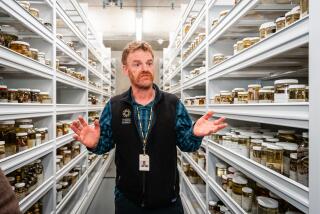Spinal-Cord Research Is Making Slow Gains
- Share via
Major discoveries in medical science are the most elusive of events. Magical advances like penicillin and the Salk polio vaccine do appear. But, in fact, the so-called breakthrough is rare. No subject is a better example of the deliberate pace of medical research than spinal-cord injury, once considered a dead end for researchers.
For years, doctors believed that damaged nerves in the spinal cord never grew back. Most of the 20,000 patients who suffer spinal injuries each year were thought to be doomed to a life of paralysis.
But recently, researchers have begun to believe that this may not necessarily be true. Laboratory evidence has indicated that the obstacle to a cure for spinal-cord injuries, although formidable, is not insurmountable. New optimism has begun to emerge.
‘Big Break a Myth’
The important thing to bear in mind, says Dr. Eugene Flamm of the New York University Medical Center, is that a cure probably won’t come all at once. “The big breakthrough is usually a mythical event,” says Flamm, vice chairman of the NYU department of neurosurgery, which is one of a small group of spinal-injury centers where such research is being conducted. “Discoveries in research are usually a series of steps, one leading to the next.”
Talking about spinal-cord research, Flamm likes to make the analogy of a chain with many links. In spinal-cord-injury research, the chain started in the 1960s when investigators began looking at what happened to the spine right after an injury. “If one went on the assumption that the minute the spinal cord is injured there is a sudden disruption of the cord, then there isn’t much you could do,” Flamm said.
But, in the vast majority of cases, researchers found that the injured cord was bruised instead of cut in two. The injury itself was likely to touch off a progression of secondary events--bleeding, swelling, a lowering of blood pressure.
“If you looked at the cord immediately, it didn’t look so bad,” Flamm continued. “In cats, an hour later you began to see blood accumulating. By four hours, you began to see more changes.” After 24 hours had passed, Flamm said, the spinal cord was either “necrotic” (dead) or “devastated.”
Fast Action May Cut Damage
Next came the concept of a “window in time” when intervention might reduce the damage, he said, because the effects of trauma were not immediate.
That concept sparked a new notion of trying to influence, and possibly limit, trauma after a spinal injury. This led to using drugs in an effort to reduce the extent of paralysis.
Like many advances in science, the drug intervention idea grew out of an experiment going in a totally different direction. At Walter Reed Army Institute of Research in Washington, D.C., Dr. Alan I. Faden, Thomas P. Jacobs and John W. Holaday were investigating the after-effects of severe blood loss.
Specifically, they were zeroing in on the role of the body’s natural painkillers, called endorphins, during massive bleeding. Although endorphins do relieve pain after injury, they also seem to trigger blood pressure drops that may lead to shock or even death. To investigate this phenomenon, the three investigators studied naloxone, a drug that could block the effects of heroin and also, they theorized, might block the body’s natural opiates.
Endorphins Blocked
To test their idea, the Washington investigators induced shock in animals, then injected them with naloxone. The drug did, in fact, block the effects of the body’s endorphins. Blood pressure stabilized and shock did not result.
The three investigators were aware that blood pressure also fell after spinal-cord injury, and they thought that the pressure drop caused by endorphins might be responsible for most of the damage. So they decided to study blood-pressure changes in spinally injured animals treated with naloxone. Naloxone did improve the blood-pressure drop, but not by much. Nonetheless, they were startled to find that, after getting naloxone, some animals recovered most of their walking ability.
“We were surprised how dramatic it was,” Jacobs said. “Over a six-week period, some animals returned almost to normal. On a scale from one to 10, we rated them eight or nine.”
The researchers reported their results in the journal Science. Newspapers picked up the story--some a bit flamboyantly. One paper’s somewhat premature headline read: “Cure for Spinal Injuries Discovered.”
At NYU, Flamm, impressed with the finding, decided to do his own naloxone study, using cats. It was a decision to embark on a practice that is often clouded by controversy.
Animal-Rights Activists
Recently, for instance, animal-rights proponents have invaded laboratories in Philadelphia and other cities where they felt animals were being treated cruelly. They want to stop experiments that, they feel, duplicate what is already known or are done only to feed “human vanity” or society’s desire for new products and gadgets.
Dr. Wise Young, director of NYU’s neurosurgical research laboratory, insists that his cats are treated humanely. Animal experiments are essential, he says, if a cure for spinal injuries is ever to come. Nevertheless, NYU researchers are acutely aware of the cruelty issue.
Says Flamm: “I have a file of crank letters saying, ‘Why don’t we use indigent patients instead of poor, helpless animals?’ People go off the deep end when they hear you are doing studies on animals.”
To prepare for the experiment, NYU technicians attempt to cause an identical injury in each cat. They anesthetize the animal. Then, they do a procedure called a laminectomy to expose an area of the spinal cord.
“The cat is put on a table and a clamp placed on the spine so it is held rigidly,” says Flamm. “A cylinder is positioned over the open spine and a 20 gram weight about the weight of a pen is dropped 20 centimeters (about eight inches) on the exposed cord. When the cat revives, it cannot walk.”
Cats Injected
Researchers inject cats with naloxone 45 minutes after injury. Control animals get an injection of salt water. Like most paralyzed humans, the injured cat cannot control its bladder and bowels. So they are placed in bins and cared for by attendants. Later, when they have contributed all the information needed in the study, they are anesthetized, killed and dissected.
The cat model is not perfect by any means. Said Flamm: “My son asked me, ‘What is the connection between what you do to animals and real life? Patients are not asleep. They haven’t had tissue removed over their spinal cord. They are sitting in a car awake, and then they have their injury.’ I told my son, ‘I’m glad you are not reviewing our grants.’
“The fact is if you create a model or facsimile of the injury you are studying, it introduces variables. For instance, the anesthesia might change the whole situation. In the end, we might be able to cure the cat model and it might have nothing to do with the patient situation. But I don’t think this is likely. When you look at the cords of patients who die after spinal injury, the similarity to the cord of injured cats is very striking.”
The results of NYU’s initial naloxone experiment were encouraging. Six of eight cats getting naloxone, or 75% of the group, regained the ability to walk. Of the controls, only one of 10, or 10 percent, walked.
Some Function Restored
The study also provided other key information. Flamm needed to know if cats getting naloxone improved even if they could not walk. By creating a free-fall harness that dropped them, then caught them in mid-air while electrically recording nerve impulses in their legs, the NYU group learned that the drug had restored some function.
“What we are doing by dropping an animal,” said Young, “is stimulating its reflex mechanisms that travel from the brain down the spinal cord to the muscles. By seeing if these impulses get through, we are beginning to see if there is return of some physiologic function in treated animals--even though they can’t turn it into walking.”
“If you give drug X to an animal and it never walks, we might conclude that the drug had no effect. But if you can see that it begins to improve function, then you begin to know something. You may need more or less of the drug. On the other hand, if you only set as your goal whether an animal walks, you will be a long time working at it.”






